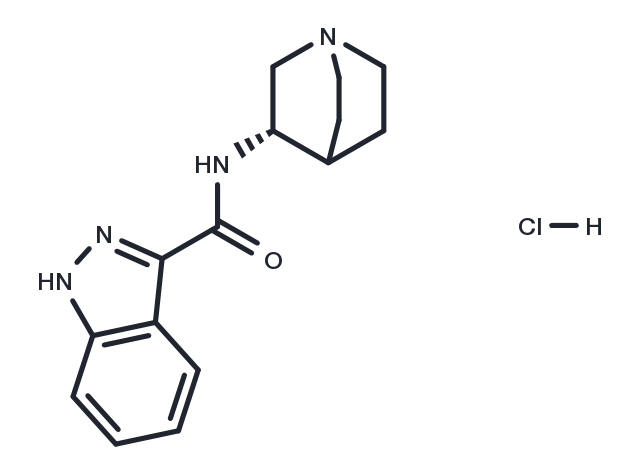Powder: -20°C for 3 years | In solvent: -80°C for 1 year


Facinicline hydrochloride (RG3487) is both a novel nicotinic alpha-7 receptor (alpha7nAChR) partial agonist (Ki = 6 nM) and an antagonist of 5-HT3(Ki = 1.2 nM). Facinicline hydrochloride improves cognition and sensorimotor gating in rodents.

| Pack Size | Availability | Price/USD | Quantity |
|---|---|---|---|
| 1 mg | In stock | $ 97.00 | |
| 5 mg | In stock | $ 247.00 | |
| 10 mg | In stock | $ 413.00 | |
| 25 mg | In stock | $ 692.00 | |
| 50 mg | In stock | $ 985.00 | |
| 100 mg | In stock | $ 1,330.00 | |
| 1 mL * 10 mM (in DMSO) | In stock | $ 272.00 |

| Description | Facinicline hydrochloride (RG3487) is both a novel nicotinic alpha-7 receptor (alpha7nAChR) partial agonist (Ki = 6 nM) and an antagonist of 5-HT3(Ki = 1.2 nM). Facinicline hydrochloride improves cognition and sensorimotor gating in rodents. |
| Targets&IC50 | α7 nAChR:6 nM (Ki), 5-HT3 receptor:1.2 nM (Ki) |
| In vitro | Facinicline hydrochloride exhibits antagonist properties at the serotonin 3 receptor in oocytes(IC50 = 2.8 μM) and N1E-115 cells(IC50 = 32.7 μM)[2].Facinicline hydrochloride activates human α7 nAChRs in oocytes(EC50 = 0.8 μM) and QM7 cells(EC50 = 7.7 μM)[2]. |
| In vivo | In Male Sprague-Dawley rats, Facinicline hydrochloride (0.1–10 mg/kg p.o.) selectively enhances object recognition memory[1]. Facinicline hydrochloride improves object recognition memory in rats after acute(1.0 mg/kg p.o.) or repeated (10 day) administration at brain and plasma concentrations in the low-nanomolar range[2]. |
| Synonyms | RG3487 |
| Molecular Weight | 306.79 |
| Formula | C15H19ClN4O |
| CAS No. | 677305-02-1 |
Powder: -20°C for 3 years | In solvent: -80°C for 1 year
H2O: 100 mg/mL (325.96 mM)
DMSO: 125 mg/mL (407.44 mM)
You can also refer to dose conversion for different animals. More
bottom
Please see Inhibitor Handling Instructions for more frequently ask questions. Topics include: how to prepare stock solutions, how to store products, and cautions on cell-based assays & animal experiments, etc.
Facinicline hydrochloride 677305-02-1 GPCR/G Protein Neuroscience AChR 5-HT Receptor Inhibitor nAChR serotonin 3 receptor Facinicline Hydrochloride RG3487 Nicotinic acetylcholine receptors Serotonin Receptor RG-3487 inhibit recognition 5-hydroxytryptamine Receptor RG 3487 Facinicline receptor memory nicotinic inhibitor
